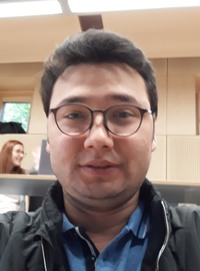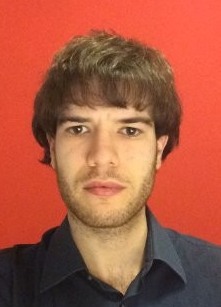 |
|
| Project: | ESR-8: PhD at University of Mons, Belgium |
| Topic: | Triplet migration and annihilation in organic conjugated materials |
| Researcher (ESR): | Mr. Rexiati (Rishat) Dilimulati |
| Supervisor: | Prof. Dr. David Beljonne |
Triplet migration and annihilation in organic conjugated materials
The experimental group from the University of Groningen had used two small push-pull molecules (SA321 and TV38) as donors and PCBM fullerene as acceptor in bulk heterojunction (BHJ) organic solar cell devices and obtained a power conversion efficiency (PCE) of 4.75% and 2.2%, respectively. The results depend on whether the active layer is formed by solution processing or vacuum deposition. The molecule SA321 has approximately two times larger lifetime and diffusion length compared to TV38 which largely affects the PCE of the solar cell.
It is not entirely understood why such similar molecules have a very different diffusion length. What factors influence the exciton diffusion length?
Morphology and/or disorder of the system have a strong influence on the exciton diffusion length. Rexiati will use Kinetic Monte Carlo (KMC) simulation to evaluate diffusion length and the other interesting parameters of the two molecules. In addition he will also use Raman and photo-absorption spectroscopy with DFT (density functional theory) and TDDFT (time-dependent density functional theory).
Contact person: David BELJONNE (
Rexiati Dilimulati
 Rexiati was born in Hoten, China. In 2017 he received his Master`s degree in theoretical physics from the Cergy-Pontoise University, Paris, France. He is currently working as a PhD researcher at the Laboratory for Chemistry of Novel Materials in Mons, Belgium, finishing his PhD.
Rexiati was born in Hoten, China. In 2017 he received his Master`s degree in theoretical physics from the Cergy-Pontoise University, Paris, France. He is currently working as a PhD researcher at the Laboratory for Chemistry of Novel Materials in Mons, Belgium, finishing his PhD.

| Project: | ESR-6: PhD at Julius Maximilians University of Würzburg, Germany |
| Topic: | Qualitative and quantitative characterization of loss mechanisms in organic solar cells |
| Researcher (ESR) | Ms. Maria Kotova |
| Supervisor: | Prof. Dr. Vladimir Dyakonov |
Qualitative and quantitative characterization of loss mechanisms in organic solar cells
Organic solar cells (OSC) possess advantages in view of potential system integration and low production costs. Still, despite significant research efforts, the performance and stability of OSC need to be further improved. To achieve this, intensive fundamental studies will be needed to clarify the recombination mechanisms, as well the intrinsic degradation processes during the conversion process of light into electricity. It is known that some of the recombination channels are spin-dependent. The magnitude of the effect is unknown, but needs to be experimentally determined in a quantitative way, or at least in relation to other molecular systems, to assess their relevance for the device performance. Various experiments will be performed that are based on the principles of electron paramagnetic resonance (EPR) in combination with electrical methods. Maria will focus her efforts on fabrication of efficient organic photovoltaic devices and their electrical characterization in a broad parameter range. Additionally, EPR techniques, such as electrically-detected EPR, will be applied to compare the density of photo-generated charges in OSCs upon application of resonant AC and DC magnetic fields Finally, she will also address the difference in behavior of OPV devices made with fullerene electron acceptors and with alternative acceptor molecules, the so-called non-fullerene acceptors. This aspect is the most recent development in the field of organic photovoltaics and will also be addressed within SEPOMO.
Please contact Prof. Dr. Vladimir Dyakonov, mail:
Maria Kotova
 Maria Kotova received her Specialist Diploma in Physics from the Lomonosov Moscow State University, Faculty of Physics, Department of Condensed Matter in 2013. Her thesis topic was “Scaling down the resistive switching effect in polymer materials” under supervision of Prof. D.R. Khokhlov. After graduation, she continued with PhD studies (2014-2018) of resistive switching effects in organic materials and devices at MSU before she joined the Chair of Experimental Physics VI at the University of Würzburg in the beginning of 2018. She participated at several international schools: summer student program at the laboratory of organic solar cells at the Institute for Heterogeneous Materials Systems of Helmholtz-Zentrum Berlin, Germany; school on memristive phenomena at Jülich Forschungszentrum; visiting scientist at Experimental Physics VI, Julius Maximilian University of Würzburg, Germany. She published several papers in the international journals, such as JETP, Organic Photonics and Photovoltaics and Journal of Nanoelectronics and Optoelectronics. She presented her research at international conferences such as ISFOE, EMRS, IFSOE. Maria is currently employed as Product Engineer at P&G Manufacturing GmbH (DE).
Maria Kotova received her Specialist Diploma in Physics from the Lomonosov Moscow State University, Faculty of Physics, Department of Condensed Matter in 2013. Her thesis topic was “Scaling down the resistive switching effect in polymer materials” under supervision of Prof. D.R. Khokhlov. After graduation, she continued with PhD studies (2014-2018) of resistive switching effects in organic materials and devices at MSU before she joined the Chair of Experimental Physics VI at the University of Würzburg in the beginning of 2018. She participated at several international schools: summer student program at the laboratory of organic solar cells at the Institute for Heterogeneous Materials Systems of Helmholtz-Zentrum Berlin, Germany; school on memristive phenomena at Jülich Forschungszentrum; visiting scientist at Experimental Physics VI, Julius Maximilian University of Würzburg, Germany. She published several papers in the international journals, such as JETP, Organic Photonics and Photovoltaics and Journal of Nanoelectronics and Optoelectronics. She presented her research at international conferences such as ISFOE, EMRS, IFSOE. Maria is currently employed as Product Engineer at P&G Manufacturing GmbH (DE).
 |
|
| Project: | ESR-2: PhD at the University of Groningen, the Netherlands |
| Topic: | Triplet exciton dynamics |
| Researcher (ESR): | Mr. Nong Hoang |
| Supervisor: | Dr. Maxim S. Pchenitchnikov |
| Co-supervisor: | Prof. Vladimir Dyakonov |
Triplet exciton dynamics
This project research aims to study the dynamics of exciton migration and dissociation in planar heterojunctions of organic semiconducting materials such as alpha-sexithiophene and fullerene. Time-resolved photoluminescence (PL) measurements are used to study fluorescent quenching and to evaluate the role of triplet states in the organic materials. Interfacial molecular orientations at interfaces plays an important role and thus will be also studied thoroughly. Afterwards, ultrafast transient absorption spectroscopy and PL measurements are used to investigate the dynamics of charge transfer and free-charge generation processes in the planar heterojunction thin-films with various interfacial molecular orientations. In term of the results of these measurements, new structures and devices are proposed to produce efficient OSCs.
For more details on the project, contact
Nong Hoang
 Nong Hoang received his Bachelor degree (2014) in Engineering Physics from the Vietnam National University, Hanoi. In 2015, he got a scholarship from Erasmus Mundus Action 2 – Swap and Transfer to study a Master programme in Organic & Molecular Electronics at the Technische Universität Dresden (Germany). He completed his Master programme (2017) with the thesis carried out at the Dresden Integrated Center for Applied Physics and Photonic Materials (IAPP) under the supervision of Professor Koen Vandewal. Currently, he is a PhD candidate (ESR-2) of the Optical Condensed Matter Physics group of the Zernike Institute for Advanced Materials, University of Groningen (NL).
Nong Hoang received his Bachelor degree (2014) in Engineering Physics from the Vietnam National University, Hanoi. In 2015, he got a scholarship from Erasmus Mundus Action 2 – Swap and Transfer to study a Master programme in Organic & Molecular Electronics at the Technische Universität Dresden (Germany). He completed his Master programme (2017) with the thesis carried out at the Dresden Integrated Center for Applied Physics and Photonic Materials (IAPP) under the supervision of Professor Koen Vandewal. Currently, he is a PhD candidate (ESR-2) of the Optical Condensed Matter Physics group of the Zernike Institute for Advanced Materials, University of Groningen (NL).
| Project: | ESR-15: PhD at Merck Chemicals Ltd, United Kingdom |
| Topic: | Study of the structure-property relations for fullerene-free organic solar cells |
| Researcher (ESR): | Mr. Pierluigi Mondelli |
| Supervisors: | Dr. Graham Morse, Dr Priti Tiwana |
| C-supervisor: | Prof. dr. Carsten Deibel |
Study of the structure-property relations for fullerene-free organic solar cells
The aim of the project is to understand the impact of consistent chemical modifications over a novel series of Non-Fullerene Acceptors molecules on the physics and the optoelectronic properties of the OPV devices, in order to open up new possibilities for a more efficient development of organic solar cells.
A particular focus will be given on the effect of the crystallinity of the acceptor domains in the blend on the charge recombination and device performance and stability.
Pierluigi Mondelli
 Mr. Pierluigi Mondelli is an Early Stage Researcher in the field of Organic PhotoVoltaics (OPV) working at Merck Chemicals Ltd. in the PV-Physics Fundamentals Department in the Chilworth Technical Center of Southampton, and a PhD candidate in the Optics and Photonics of Condensed Matter Physics Department in the University of Chemnitz. He started his research project within the ITN SEPOMO (Spins for Efficient Photovoltaic Devices based on Organic Molecules) network and his recent activity in Solution-Processed Organic Photovoltaics is focusing on the electronic and optoelectronic characterization of a new generation of Non-Fullerene Acceptors, looking into the dynamics and the role of the charge-transfer state with respect to the energy losses which are responsible for a lower Power Conversion Efficiency of OPV devices compared to inorganic solar cells. His field of expertise is ranging from mechanical engineering to nanotechnology and material science, being trained at the University of Rome “La Sapienza” and further working at the Queensland University of Technology in Brisbane (Australia) towards the integration of graphene into the silicon-based industry. He also worked as a research fellow for the Physics Department of the University of Rome “La Sapienza” on the magnetic properties of organo-metallic molecules grown on intercalated graphene systems. The main results of his research activities are already contained in several publications in peer-reviewed journals and posters presented in international conferences.
Mr. Pierluigi Mondelli is an Early Stage Researcher in the field of Organic PhotoVoltaics (OPV) working at Merck Chemicals Ltd. in the PV-Physics Fundamentals Department in the Chilworth Technical Center of Southampton, and a PhD candidate in the Optics and Photonics of Condensed Matter Physics Department in the University of Chemnitz. He started his research project within the ITN SEPOMO (Spins for Efficient Photovoltaic Devices based on Organic Molecules) network and his recent activity in Solution-Processed Organic Photovoltaics is focusing on the electronic and optoelectronic characterization of a new generation of Non-Fullerene Acceptors, looking into the dynamics and the role of the charge-transfer state with respect to the energy losses which are responsible for a lower Power Conversion Efficiency of OPV devices compared to inorganic solar cells. His field of expertise is ranging from mechanical engineering to nanotechnology and material science, being trained at the University of Rome “La Sapienza” and further working at the Queensland University of Technology in Brisbane (Australia) towards the integration of graphene into the silicon-based industry. He also worked as a research fellow for the Physics Department of the University of Rome “La Sapienza” on the magnetic properties of organo-metallic molecules grown on intercalated graphene systems. The main results of his research activities are already contained in several publications in peer-reviewed journals and posters presented in international conferences.
